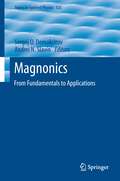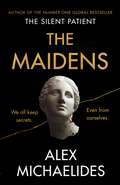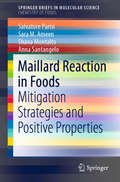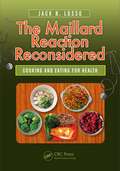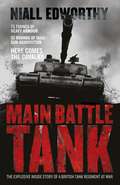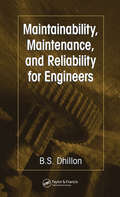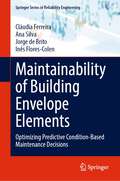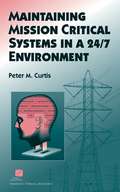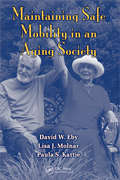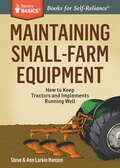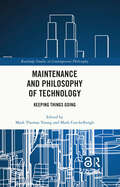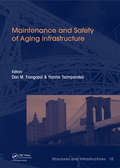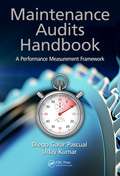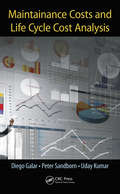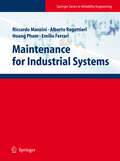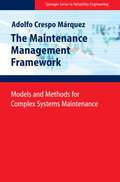- Table View
- List View
Magnonic Devices: Numerical Modelling and Micromagnetic Simulation Approach (SpringerBriefs in Materials)
by C. S. Nikhil KumarThis book briefly looks at numerical modeling and micromagnetic simulation results of magnonic crystals, which are periodically modulated magnonic devices regarded as the magnetic counterpart of photonic crystals with spin waves acting as the information carrier. Since the wavelength of the spin wave is several orders of magnitude shorter than that of electromagnetic waves of the same frequency, magnonic crystals are promising candidates for miniaturization, especially in the fields of data storage and processing. The book begins by describing the dispersion relation of dipolar spin waves in a magnonic curved waveguide, solving Walker's equation in cylindrical coordinates, and then calculating the dispersion of exchange spin waves using perturbation theory. It describes simulated nano-contact-driven spin wave excitations in a magnonic cavity, featuring a design of an antidot magnonic crystal around the nano-contact, with the frequency of the spin wave mode generated lying within the band gap of the magnonic crystal. The proposed device behaves as a SWASER—Spin Wave Amplification by the Stimulated Emission of Radiation. This book will find interest among researchers and practitioners interested in the modeling, simulation, and design of novel magnonic devices.
Magnonics: From Fundamentals to Applications (Topics in Applied Physics #125)
by Sergej O. Demokritov and Andrei N. SlavinSpin waves (and their quanta magnons) can effectively carry and process information in magnetic nanostructures. By analogy to photonics, this research field is labelled magnonics. It comprises the study of excitation, detection, and manipulation of magnons. From the practical point of view, the most attractive feature of magnonic devices is the controllability of their functioning by an external magnetic field. This book has been designed for students and researchers working in magnetism. Here the readers will find review articles written by leading experts working on realization of magnonic devices.
The Maidens: The new thriller from the author of the global bestselling debut The Silent Patient
by Alex MichaelidesWe all keep secrets. Even from ourselves.'A thrilling, heart-in-throat ride' STEPHEN FRY'An absolute jaw-dropper' LUCY FOLEYFrom the author of the global #1 bestselling debut The Silent Patient comes a spellbinding literary thriller weaving together Greek mythology, psychology, and murder...* * * * *St Christopher's College, Cambridge, is a closed world to most.For Mariana Andros - a group therapist struggling through her private grief - it's where she met her late husband. For her niece, Zoe, it's the tragic scene of her best friend's murder.As memory and mystery entangle Mariana, she finds a society full of secrets, which has been shocked to its core by the murder of one of its own.Because behind its idyllic beauty is a web of jealousy and rage which emanates from an exclusive set of students known only as The Maidens. A group under the sinister influence of the enigmatic professor Edward Fosca.A man who seems to know more than anyone about the murders - and the victims. And the man who will become the prime suspect in Mariana's investigation - an obsession which will unravel everything...The Maidens is a story of love, and of grief - of what makes us who we are, and what makes us kill.* * * * *'Elegant, sinister, stylish and thrilling, The Maidens answers the weighty question, how do you go about following one of the biggest thrillers of the past decade? You write something even better.' CHRIS WHITAKER, bestselling author of WE BEGIN AT THE END'Grips from intriguing start to horrifying finish ... A brilliant achievement.'HARRIET TYCE'A page-turner of the first order'DAVID BALDACCI'The greatest campus novel since The Secret History by Donna Tartt ... with a climatic twist that you will NEVER see coming.'TONY PARSONS'A stunning psychological thriller ... Michaelides is on a roll.'PUBLISHERS WEEKLY
Maidens' Trip
by Emma SmithIn 1943 Emma Smith joined the Grand Union Canal Carrying Company under their wartime scheme of employing women to replace the boaters. She set out with two friends on a big adventure: three eighteen-year-olds, freed from a middle-class background, precipitated into the boating fraternity. They learn how to handle a pair of seventy-two foot-long canal boats, how to carry a cargo of steel north from London to Birmingham and coal from Coventry; how to splice ropes, bail out bilge water, keep the engine ticking over and steer through tunnels. They live off kedgeree and fried bread and jam, adopt a kitten, lose their bicycles, laugh and quarrel and get progressively dirtier and tougher as the weeks go by. Maidens' Trip is a classic memoir of the growth to maturity of three young women in the exceptional circumstances of Britain at war.
The Maillard Reaction in Food Chemistry: Current Technology and Applications (SpringerBriefs in Molecular Science)
by Dongliang Ruan Hui Wang Faliang ChengThis book is devoted to the characterization of Maillard reaction products using mass spectrometry (MS)-based technologies. The Maillard reaction is a well-known non-enzymatic reaction between reducing sugars and proteins, and one of the most important reactions in food sciences. The authors explore different MS-based technologies to systematically investigate the Maillard reaction from amino acids, peptides and proteins. By using amino acid/peptide-sugar models, the authors also show how reactants, temperature and time affect the Maillard reaction. In this book, readers will learn more about glucosylation, and how it can improve functional properties of food proteins.
Maillard Reaction in Foods: Mitigation Strategies and Positive Properties (SpringerBriefs in Molecular Science)
by Salvatore Parisi Sara M. Ameen Anna Santangelo Shana MontaltoThis book provides an overview of mitigation strategies and positive health effects of Maillard Reaction products in the contexts of food processing and storage. The effects of Maillard Reactions can vary considerably: while on the one hand certain sensorial alterations and influences on color, flavor and odor may be desirable, Maillard Reactions can also result in potentially harmful and toxic products (e.g. furfurals, furosines, or acrylamide). This book discusses possible mitigation strategies for the reduction of toxic reaction products, including the addition of enzymes or antioxidants, reducing sugars, and encapsulation approaches, as well as new processing strategies, such as high-pressure, radio-frequency, ultrahigh-temperature, or Ohmic heating methods. The book also illustrates that certain Maillard products can even produce positive health effects, e.g. antimicrobial or anticarcinogenic effects. The methods described here can serve as a blueprint for promoting the formation of beneficial compounds and reducing / avoiding toxic substances, offering essential strategies and methods.
The Maillard Reaction Reconsidered: Cooking and Eating for Health
by Jack N. LossoCooking involves chemical reactions that can make food smell and taste better. However, the same process that is responsible for creating the aroma, flavor, palatability, color, and taste of grilled and seared foods has also been linked to the development of chronic degenerative diseases. The Maillard reaction produces advanced glycation end produc
Main Battle Tank
by Niall EdworthyThe British Army's Challenger II Main Battle Tank is one of the most awesome war machines ever built. In March 2003, three Squadrons of Challenger 2s from the Royal Scots Dragoon Guards, part of Britain's 7th Armoured Brigade, the fabled Desert Rats, gathered in Southern Iraq to prepare for battle.The Army's newest Big Guns were going to war for the first time.But Operation TELIC was a war which the Challenger 2, designed to operate in the fog and mud of the Central European Plain, had never been expected to fight. And one that would quickly break every rule of tank warfare including the golden maxim: never take a tank into a town. In Main Battle Tank, author Niall Edworthy, granted unprecedented access to the Scots DGs, tells the story of an extraordinary chapter in the history of British Army. From the terrifying rescue of a stricken Challenger 2 and countless nerve-shredding raids into Basra and Az Zubyar, to the biggest tank engagement fought by the British since the end of WWII, Main Battle Tank is the brutal, blistering true story of a war that tested man and machine to the bloody limit.
Maintainability, Maintenance, and Reliability for Engineers
by B.S. DhillonThe demands of the global economy require manufacturers to produce highly reliable and easily maintainable engineering products. Recent studies indicate that for many large and sophisticated products or systems, maintenance, and support account for as much as 60 to 75 percent of their life cycle costs. Therefore, the role of maintainability, mainte
Maintainability of Building Envelope Elements: Optimizing Predictive Condition-Based Maintenance Decisions (Springer Series in Reliability Engineering)
by Cláudia Ferreira Ana Silva Jorge de Brito Inês Flores-ColenThis book introduces a maintenance model that will assist decision-makers in their choice of building maintenance policies. The model is stochastic and condition-based that analyses the impact of different maintenance strategies on the durability and performance of different buildings envelope elements (facades, windows, and roofs). As non-structural elements, the maintenance of buildings envelope can be disregarded stakeholders. However, as first barrier to the external environment, these elements are critical to buildings' overall performance and are expected to meet aesthetic, comfort, safety, and durability requirements. The methodology presented is innovative. The maintenance model is based on a Petri net formalism and includes degradation, inspection, maintenance, and renewal processes. The model provides key information, such as: i) the impact of different maintenance strategies on the service life and durability of the building components; ii) the impact of maintenance on their performance over time; iii) the life cycle costs; and iv) the impact of maintenance on the buildings' use. The book will be of use to a variety of professionals in the construction sector.
Maintaining Mission Critical Systems in a 24/7 Environment (IEEE Press Series on Power Engineering #23)
by Peter M. CurtisThe latest tested and proven strategies to maintain business resiliency and sustainability for our ever-growing global digital economy Here is a comprehensive study of the fundamentals of mission critical systems, which are designed to maintain ultra-high reliability, availability, and resiliency of electrical, mechanical, and digital systems and eliminate costly downtime. Readers learn all the skills needed to design, fine tune, operate, and maintain mission critical equipment and systems. Practical in focus, the text helps readers configure and customize their designs to correspond to their organizations' unique needs and risk tolerance. Specific strategies are provided to deal with a wide range of contingencies from power failures to human error to fire. In addition, the author highlights measures that are mandated by policy and regulation. The author of this text has worked in mission critical facilities engineering for more than twenty years, serving clients in banking, defense, utilities, energy, and education environments. His recommendations for maintaining essential operations are based on firsthand experience of what works and what does not. Most chapters in this text concentrate on an individual component of the mission critical system, including standby generators, automatic transfer switches, uninterruptible power supplies, and fuel, fire, and battery systems. For each component, the author sets forth applications, available models, design choices, standard operating procedures, emergency action plans, maintenance procedures, and applicable codes and standards. Extensive use of photographs and diagrams illustrates how individual components and integrated systems work. With the rapid growth of e-commerce and 24/7 business operations, mission critical systems have moved to the forefront of concerns among both private and public operations. Facilities engineers, senior administrators, and business continuity professionals involved in information technology and data center design should consult this text regularly to ensure they have done everything they can to protect and sustain their operations to reduce human error, equipment failures, and other critical events. Adapted from material the author has used in academic and professional training programs, this guide is also an ideal desktop reference and textbook.
Maintaining Safe Mobility in an Aging Society
by David W. Eby Lisa J. Molnar Paula S. KartjeBy 2030, 20 percent of the world's drivers, 60 million in all, will be over the age of 65. Consequently, safe and efficient mobility for older adults is a complex and pressing issue. Maintaining Safe Mobility in an Aging Society addresses the complexities surrounding the booming number of aging drivers and practical solutions for sustaining safe tr
Maintaining Small-Farm Equipment: How to Keep Tractors and Implements Running Well. A Storey BASICS® Title (Storey Basics)
by Steve Hansen Ann Larkin HansenA smooth-running tractor or other basic piece of farm equipment can be the key to a successful farm, yet many newcomers enter farming with no knowledge of how an engine works, how to maintain and fix a tractor or implement so it will last a lifetime, or how to maximize operator safety. This handy, practical guide can save those farmers thousands of dollars in repairs and lost productivity.
Maintenance and Philosophy of Technology: Keeping Things Going (Routledge Studies in Contemporary Philosophy)
by Mark Thomas Young Mark CoeckelberghWhat can we learn about the nature of technology by studying practices of maintenance and repair? This volume addresses this question by bringing together scholarship from philosophers of technology working at the forefront of this emerging and exciting topic.The chapters in this volume explore how attending to maintenance and repair can challenge and complement existing ways of thinking about technology focused on use and design and introduce new philosophical perspectives on the relationship between technology, time and human practice. They examine the significance of maintenance and repair practices at different scales in relation to a diverse range of philosophical traditions and a wide variety of technologies, from urban infrastructure such as bridges and buildings to data technologies such as servers and software systems. Together, the contributions highlight common themes in the philosophical study of maintenance, including the role of skill, the significance of social values and the potential of these practices to transform the technologies to which they are applied. By reflecting on the different ways in which we keep technologies going, from the devices we use in our homes to the large technical systems which surround us, this volume reveals the philosophical significance of practices of maintenance, not only as a source of new insights but also as a resource for enriching our understanding of a variety of existing topics in philosophy.Maintenance and Philosophy of Technology will appeal to scholars and advanced students working in philosophy of technology, philosophy of engineering and science & technology studies.Chapter 9 of this book is freely available as a downloadable Open Access PDF at www.taylorfrancis.com under a Creative Commons Attribution-Non Commercial-No Derivatives (CC-BY-NC-ND) 4.0 license.
Maintenance and Philosophy of Technology: Keeping Things Going (Routledge Studies in Contemporary Philosophy)
What can we learn about the nature of technology by studying practices of maintenance and repair? This volume addresses this question by bringing together scholarship from philosophers of technology working at the forefront of this emerging and exciting topic.The chapters in this volume explore how attending to maintenance and repair can challenge and complement existing ways of thinking about technology focused on use and design and introduce new philosophical perspectives on the relationship between technology, time and human practice. They examine the significance of maintenance and repair practices at different scales in relation to a diverse range of philosophical traditions and a wide variety of technologies, from urban infrastructure such as bridges and buildings to data technologies such as servers and software systems. Together, the contributions highlight common themes in the philosophical study of maintenance, including the role of skill, the significance of social values and the potential of these practices to transform the technologies to which they are applied. By reflecting on the different ways in which we keep technologies going, from the devices we use in our homes to the large technical systems which surround us, this volume reveals the philosophical significance of practices of maintenance, not only as a source of new insights but also as a resource for enriching our understanding of a variety of existing topics in philosophy.Maintenance and Philosophy of Technology will appeal to scholars and advanced students working in philosophy of technology, philosophy of engineering and science & technology studies.Chapter 9 of this book is freely available as a downloadable Open Access PDF at www.taylorfrancis.com under a Creative Commons Attribution-Non Commercial-No Derivatives (CC-BY-NC-ND) 4.0 license.
Maintenance and Safety of Aging Infrastructure: Structures and Infrastructures Book Series, Vol. 10 (Structures And Infrastructures Ser. #10)
by Dan Frangopol Yiannis TsompanakisThis book presents the latest research findings in the field of maintenance and safety of aging infrastructure. The invited contributions provide an overview of the use of advanced computational and/or experimental techniques in damage and vulnerability assessment as well as maintenance and retrofitting of aging structures and infrastructures such
Maintenance Audits Handbook: A Performance Measurement Framework
by Uday Kumar Diego Galar PascualThis book addresses issues and challenges of performance measurement in the maintenance function. It presents a proposal of indicators with a framework that classifies and sorts regarding functional and hierarchical aspects. The book has been developed with different aspects of traditional literature, i.e. several frameworks (or natural groupings) like BSC Balanced Scorecard, Multicriteria framework, Neely Prism and adaptation of these frameworks. Hierarchies for the use of indicators and benchmark values are provided to allow quantification, comparison and emission of recommendations.
Maintenance Audits Handbook: A Performance Measurement Framework
by Uday Kumar Diego Galar PascualThis book addresses issues and challenges of performance measurement in the maintenance function. It presents a proposal of indicators with a framework that classifies and sorts regarding functional and hierarchical aspects. The book has been developed with different aspects of traditional literature, i.e. several frameworks (or natural groupings) like BSC Balanced Scorecard, Multicriteria framework, Neely Prism and adaptation of these frameworks. Hierarchies for the use of indicators and benchmark values are provided to allow quantification, comparison and emission of recommendations.
Maintenance Costs and Life Cycle Cost Analysis
by Diego Galar Peter Sandborn Uday KumarAuthors have attempted to create coherent chapters and sections on how the fundamentals of maintenance cost should be organized, to present them in a logical and sequential order. Necessarily, the text starts with importance of maintenance function in the organization and moves to life cycle cost (LCC) considerations followed by the budgeting constraints. In the process, they have intentionally postponed the discussion about intangible costs and downtime costs later on in the book mainly due to the controversial part of it when arguing with managers. The book will be concluding with a short description of a number of sectors where maintenance cost is of critical importance. The goal is to train the readers for a deeper study and understanding of these elements for decision making in maintenance, more specifically in the context of asset management. This book is intended for managers, engineers, researchers, and practitioners, directly or indirectly involved in the area of maintenance. The book is focused to contribute towards better understanding of maintenance cost and use of this knowledge to improve the maintenance process. Key Features: • Emphasis on maintenance cost and life cycle cost especially under uncertainty. • Systematic approach of how cost models can be applied and used in the maintenance field. • Compiles and reviews existing maintenance cost models. • Consequential and direct costs considered. • Comparison of maintenance costs in different sectors, infrastructure, manufacturing, transport.
Maintenance Costs and Life Cycle Cost Analysis
by Diego Galar Peter Sandborn Uday KumarAuthors have attempted to create coherent chapters and sections on how the fundamentals of maintenance cost should be organized, to present them in a logical and sequential order. Necessarily, the text starts with importance of maintenance function in the organization and moves to life cycle cost (LCC) considerations followed by the budgeting constraints. In the process, they have intentionally postponed the discussion about intangible costs and downtime costs later on in the book mainly due to the controversial part of it when arguing with managers. The book will be concluding with a short description of a number of sectors where maintenance cost is of critical importance. The goal is to train the readers for a deeper study and understanding of these elements for decision making in maintenance, more specifically in the context of asset management. This book is intended for managers, engineers, researchers, and practitioners, directly or indirectly involved in the area of maintenance. The book is focused to contribute towards better understanding of maintenance cost and use of this knowledge to improve the maintenance process. Key Features: • Emphasis on maintenance cost and life cycle cost especially under uncertainty. • Systematic approach of how cost models can be applied and used in the maintenance field. • Compiles and reviews existing maintenance cost models. • Consequential and direct costs considered. • Comparison of maintenance costs in different sectors, infrastructure, manufacturing, transport.
Maintenance for Industrial Systems (Springer Series in Reliability Engineering)
by Riccardo Manzini Alberto Regattieri Hoang Pham Emilio FerrariNew, global and extended markets are forcing companies to process and manage increasingly differentiated products with shorter life cycles, low volumes and reduced customer delivery times. In today’s global marketplace production systems need to be able to deliver products on time, maintain market credibility and introduce new products and services faster than competitors. As a result, a new production paradigm of a production system has been developed and a supporting management decision-making approach simultaneously incorporating design, management, and control of the production system is necessary so that this challenge can be effectively and efficiency met. "Maintenance Engineering and its Applications in Production Systems" meets this need by introducing an original and integrated idea of maintenance: maintenance for productivity. The volume starts with the introduction and discussion of a new conceptual framework based on productivity, quality, and safety supported by maintenance. Subsequent chapters illustrate the most relevant models and methods to plan, organise, implement and control the whole maintenance process (reliability evaluation models and prediction, maintenance strategies and policies, spare parts management, computer maintenance management software – CMMS, and total productive maintenance – TPM, etc.). Several examples of problems supported by solutions, and real applications to help and test the reader’s comprehension are included. "Maintenance Engineering and its Applications in Production Systems" will certainly be valuable to engineering students, doctoral and post-doctoral students and also to maintenance practitioners, as well as managers of industrial and service companies.
The Maintenance Management Framework: Models and Methods for Complex Systems Maintenance (Springer Series in Reliability Engineering)
by Adolfo Crespo Márquez“The Maintenance Management Framework” describes and reviews the concept, process and framework of modern maintenance management of complex systems; concentrating specifically on modern modelling tools (deterministic and empirical) for maintenance planning and scheduling. It will be bought by engineers and professionals involved in maintenance management, maintenance engineering, operations management, quality, etc. as well as graduate students and researchers in this field.
Maintenance Management in Network Utilities: Framework and Practical Implementation (Springer Series in Reliability Engineering)
by Juan F Gómez Fernández Adolfo Crespo MárquezIn order to satisfy the needs of their customers, network utilities require specially developed maintenance management capabilities. Maintenance Management information systems are essential to ensure control, gain knowledge and improve-decision making in companies dealing with network infrastructure, such as distribution of gas, water, electricity and telecommunications. Maintenance Management in Network Utilities studies specified characteristics of maintenance management in this sector to offer a practical approach to defining and implementing the best management practices and suitable frameworks. Divided into three major sections, Maintenance Management in Network Utilities defines a series of stages which can be followed to manage maintenance frameworks properly. Different case studies provide detailed descriptions which illustrate the experience in real company situations. An introduction to the concepts is followed by main sections including:• A Literature Review: covering the basic concepts and models needed for framework design, development and implementation.• Framework Design and Definition: developing the basic pillars of network utilities maintenance management framework.• Performance Evaluation & Maturity: focusing on the reliability concept and maturity models from different viewpoints. By establishing basic foundations for creating and maintaining maintenance managements strategies, Maintenance Management in Network Utilities acts a practical handbook for all professionals in these companies and across areas such as network development, operations management and marketing.
Maintenance, Modeling and Optimization
by Mohamed Ben-Daya Salih O. Duffuaa Abdul RaoufProduction costs are being reduced by automation, robotics, computer-integrated manufacturing, cost reduction studies and more. These new technologies are expensive to buy, repair, and maintain. Hence, the demand on maintenance is growing and its costs are escalating. This new environment is compelling industrial maintenance organizations to make the transition from fixing broken machines to higher-level business units for securing production capacity. On the academic front, research in the area of maintenance management and engineering is receiving tremendous interest from researchers. Many papers have appeared in the literature dealing with the modeling and solution of maintenance problems using operations research (OR) and management science (MS) techniques. This area represents an opportunity for making significant contributions by the OR and MS communities. Maintenance, Modeling, and Optimization provides in one volume the latest developments in the area of maintenance modeling. Prominent scholars have contributed chapters covering a wide range of topics. We hope that this initial contribution will serve as a useful informative introduction to this field that may permit additional developments and useful directions for more research in this fast-growing area. The book is divided into six parts and contains seventeen chapters. Each chapter has been subject to review by at least two experts in the area of maintenance modeling and optimization. The first chapter provides an introduction to major maintenance modeling areas illustrated with some basic models. Part II contains five chapters dealing with maintenance planning and scheduling. Part III deals with preventive maintenance in six chapters. Part IV focuses on condition-based maintenance and contains two chapters. Part V deals with integrated production and maintenance models and contains two chapters. Part VI addresses issues related to maintenance and new technologies, and also deals with Just-in-Time (JIT) and Maintenance.
Maintenance, Monitoring, Safety, Risk and Resilience of Bridges and Bridge Networks (Bridge Maintenance, Safety and Management)
by Tulio Nogueira Bittencourt Dan M. Frangopol Andre BeckMaintenance, Monitoring, Safety, Risk and Resilience of Bridges and Bridge Networks contains the lectures and papers presented at the Eighth International Conference on Bridge Maintenance, Safety and Management (IABMAS 2016), held in Foz do Iguaçu, Paraná, Brazil, 26-30 June, 2016. This volume consists of a book of extended abstracts and a DVD containing the full papers of 369 contributions presented at IABMAS 2016, including the T.Y. Lin Lecture, eight Keynote Lectures, and 360 technical papers from 38 countries. The contributions deal with the state-of-the-art as well as emerging concepts and innovative applications related to all main aspects of bridge maintenance, safety, management, resilience and sustainability. Major topics covered include: advanced materials, ageing of bridges, assessment and evaluation, bridge codes, bridge diagnostics, bridge management systems, composites, damage identification, design for durability, deterioration modeling, earthquake and accidental loadings, emerging technologies, fatigue, field testing, financial planning, health monitoring, high performance materials, inspection, life-cycle performance and cost, load models, maintenance strategies, non-destructive testing, optimization strategies, prediction of future traffic demands, rehabilitation, reliability and risk management, repair, replacement, residual service life, resilience, robustness, safety and serviceability, service life prediction, strengthening, structural integrity, and sustainability. This volume provides both an up-to-date overview of the field of bridge engineering as well as significant contributions to the process of making more rational decisions concerning bridge maintenance, safety, serviceability, resilience, sustainability, monitoring, risk-based management, and life-cycle performance using traditional and emerging technologies for the purpose of enhancing the welfare of society. It will serve as a valuable reference to all involved with bridge structure and infrastructure systems, including students, researchers and engineers from all areas of bridge engineering.

